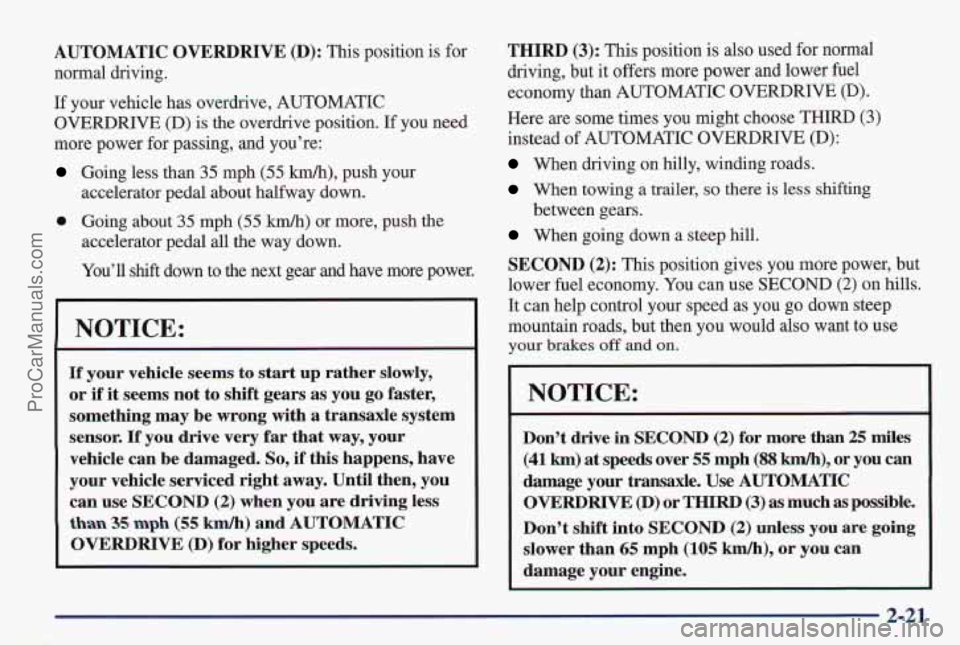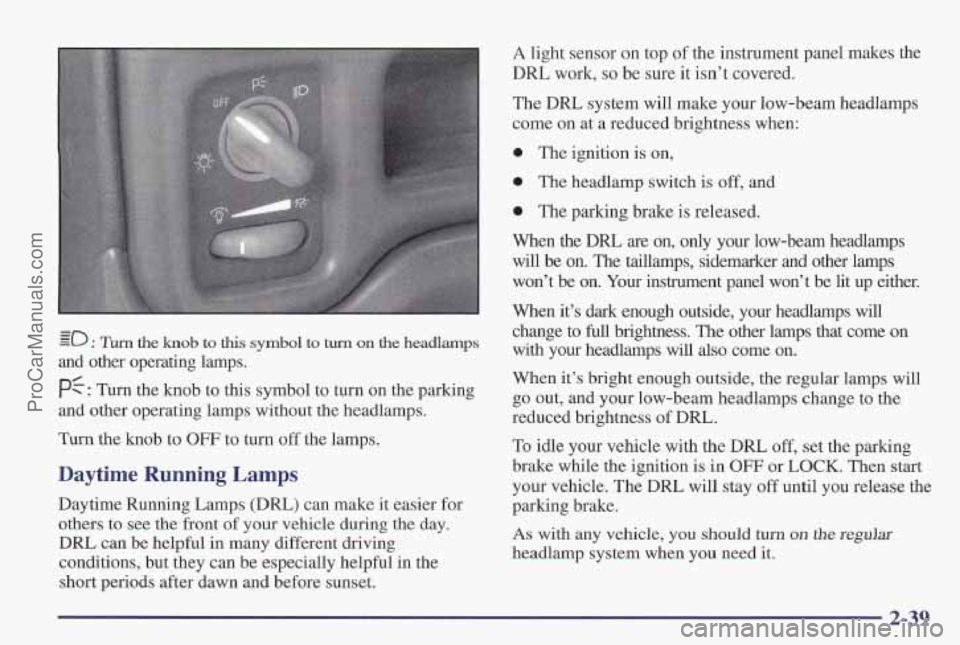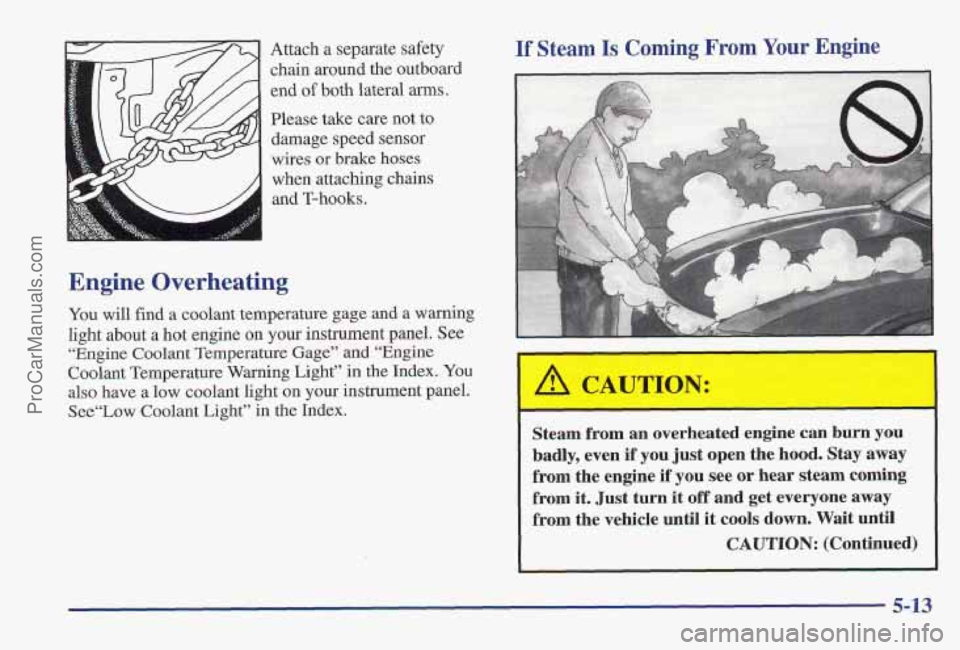brake sensor PONTIAC PONTIAC 1997 Owners Manual
[x] Cancel search | Manufacturer: PONTIAC, Model Year: 1997, Model line: PONTIAC, Model: PONTIAC PONTIAC 1997Pages: 419, PDF Size: 19.67 MB
Page 95 of 419

AUTOMATIC OVERDRIVE (D): This position is for
normal driving.
If your vehicle has overdrive, AUTOMATIC
OVERDRIVE
(D) is the overdrive position. If you need
more power for passing, and you’re:
Going less than 35 mph (55 km/h), push your
0 Going about 35 mph (55 kmh) or more, push the
accelerator
pedal about halfway down.
accelerator pedal all the way down.
You’ll
shift down to the next gear and have more power.
NOTICE:
If your vehicle seems to start up rather slowly,
or
if it seems not to shift gears as you go faster,
something may be wrong with
a transaxle system
sensor.
If you drive very far that way, your
vehicle can be damaged.
So, if this happens, have
your vehicle serviced right
away. Until then, you
can use SECOND
(2) when you are driving less
than 35 mph (55 km/h) and AUTOMATIC
OVERDRIVE (D) for higher speeds. THIRD
(3): This
position is also used for normal
driving, but it offers more power and lower fuel
economy than AUTOMATIC OVERDRIVE
(D).
Here are some times you might choose THIRD (3)
instead of AUTOMATIC OVERDRIVE (D):
When driving on hilly, winding roads.
When towing a trailer, so there is less shifting
When going down a steep hill.
SECOND (2): This position gives you more power, but
lower fuel economy. You can use SECOND
(2) on hills.
It can help control your speed as you go down steep
mountain roads, but then you would also want to use
your brakes off and on.
between gears.
NOTICE:
Don’t drive in SECOND (2) for more than 25 miles
(41 km) at speeds over 55 mph (88 km/h), or you can
damage your transaxle. Use AUTOMATIC
OVERDRIVE (D) or THIRD (3) as much as possible.
Don’t shift into
SECOND (2) unless you are going
slower than
65 mph (105 km/h), or you can
damage your engine.
2-21
ProCarManuals.com
Page 113 of 419

go : Turn the knob to this symbol to turn on the headlamps
and other operating lamps.
PG: Turn the knob to this symbol to turn on the parking
and other operating lamps without the headlamps.
Turn the knob to
OFF to turn off the lamps.
Daytime Running Lamps
Daytime Running Lamps (DRL) can make it easier for
others to see the front of your vehicle during the day.
DRL can be helpful in many different driving
conditions,
but they can be especially helpful in the
short periods after dawn and before sunset.
A light sensor on top of the instrument panel makes the
DRL work, so be sure it isn't covered.
The DRL system will make your low-beam headlamps
come on at a reduced brightness when:
0 The ignition is on,
0 The headlamp switch is off, and
0 The parking brake is released.
When the
DRL are on, only your low-beam headlamps
will be on. The taillamps, sidemarker and other lamps
won't be on. Your instrument panel won't be lit up either.
When it's dark enough outside, your headlamps will change to full brightness. The other lamps that come on
with your headlamps will also come on.
When it's bright enough outside, the regular lamps will
go out, and your low-beam headlamps change to the
reduced brightness of DRL.
To idle your vehicle with the DRL off, set the parking
brake while the ignition is in
OFF or LOCK. Then start
your vehicle. The DRL will stay
off until you release the
parking brake.
As with any vehicle, you should turn on the regular
headlamp system when you need it.
ProCarManuals.com
Page 247 of 419

Attach a separate safety
chain around the outboard
end
of both lateral arms.
Please take care not to
damage speed sensor
wires or brake
hoses
when attaching chains
l.1 and T-hooks. -
Engine Overheating
You will find a coolant temperature gage and a warning
light about
a hot engine on your instrument panel. See
“Engine Coolant Temperature Gage” and “Engine
Coolant Temperature Warning Light” in the Index.
You
also have a low coolant light on your instrument panel.
Sed‘Low Coolant Light” in the Index.
If Steam Is Coming From Your Engine
Steam from an overheated engine can burn you
badly, even if you just open the hood. Stay away
from the engine if you see or hear steam coming
from it. Just turn it off and get everyone away
from the vehicle until it cools down. Wait until
CAUTION: (Continued)
5-13
ProCarManuals.com